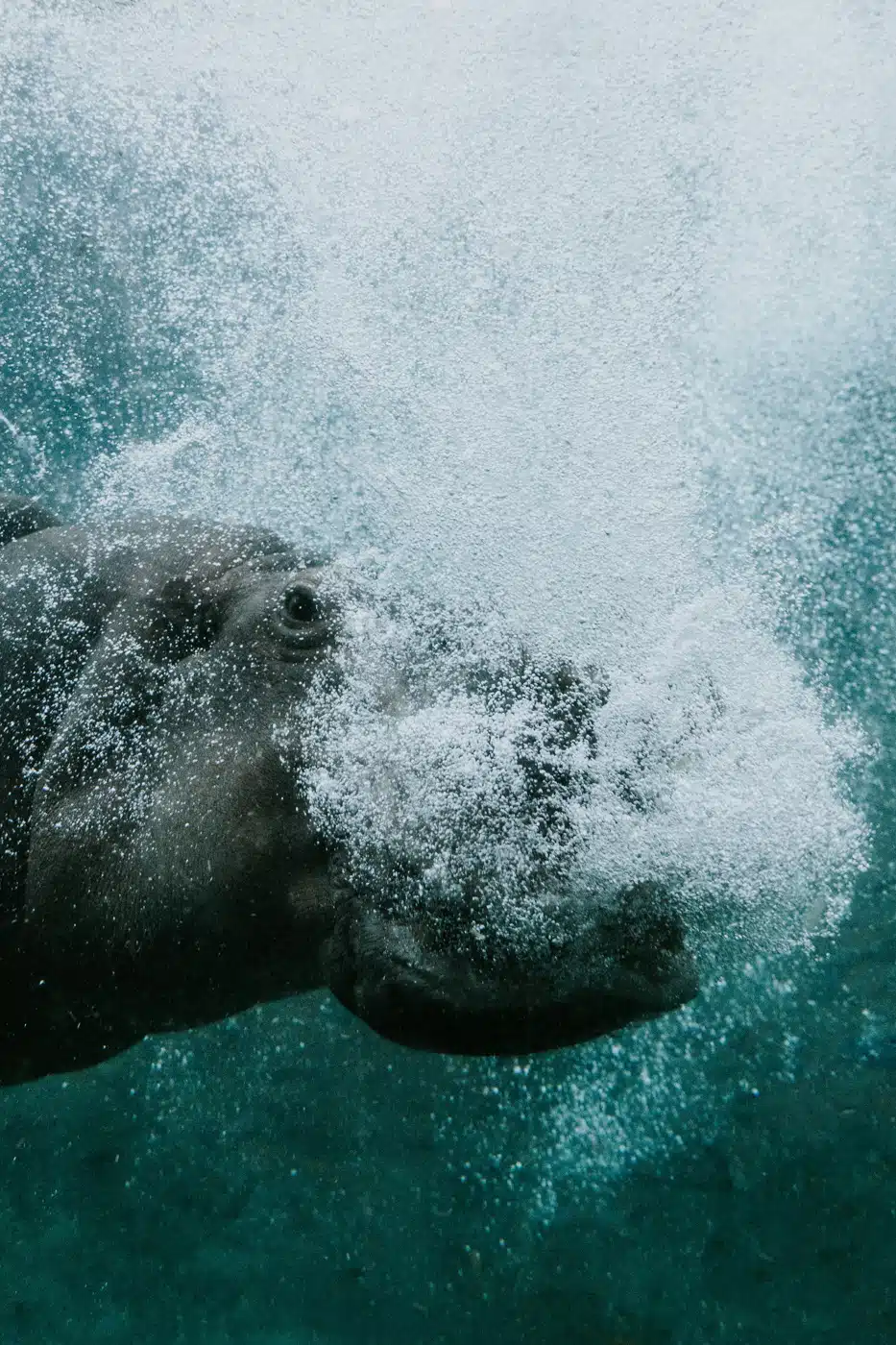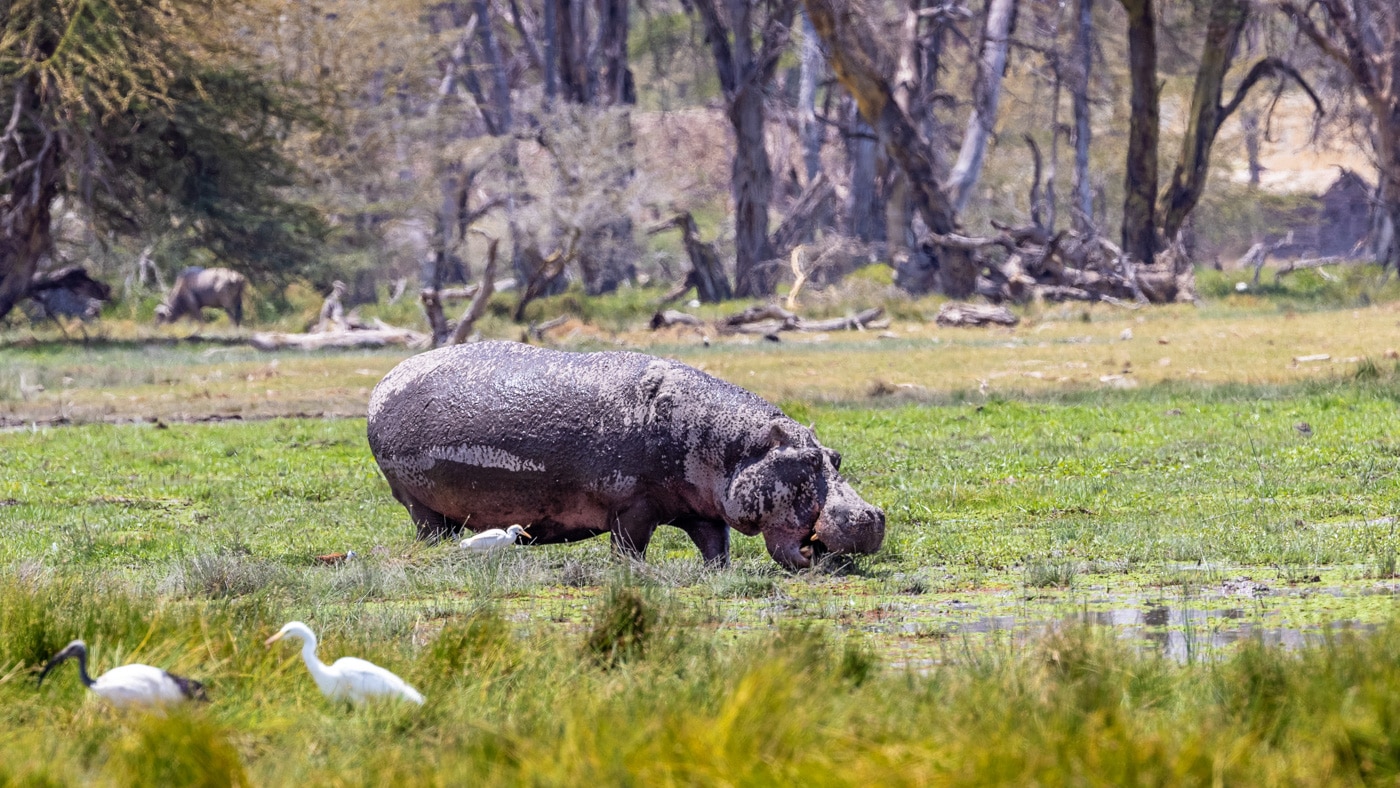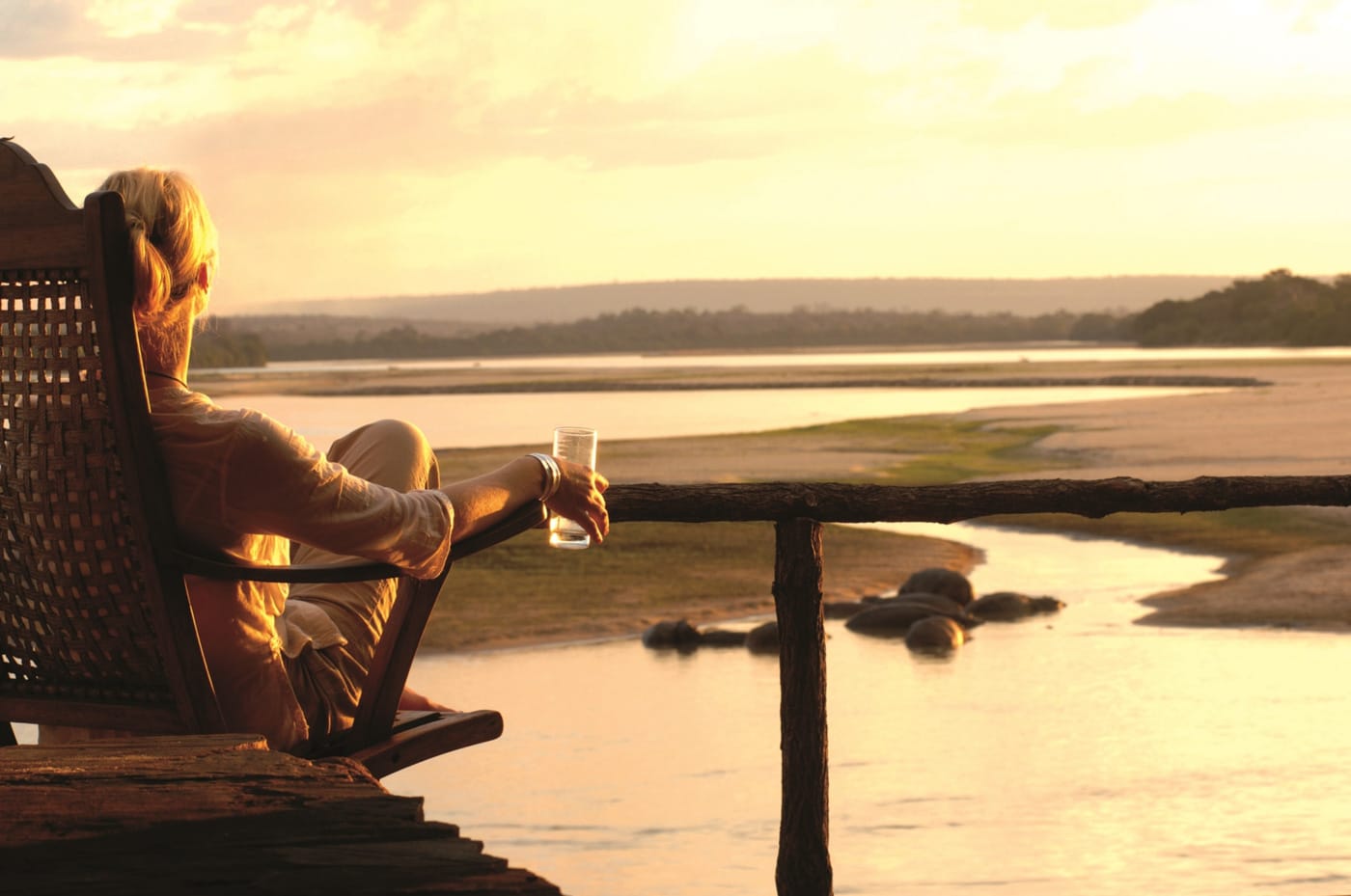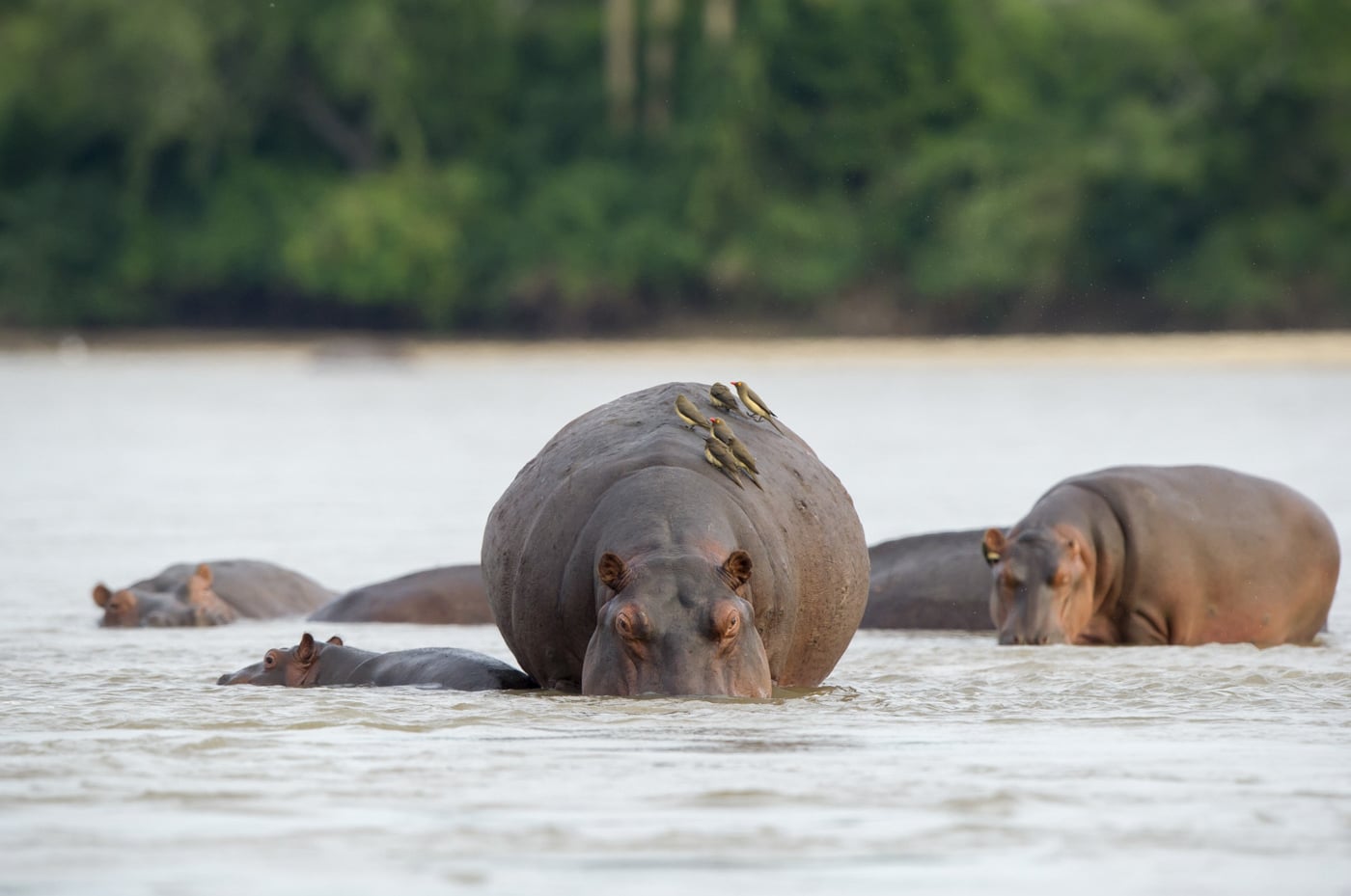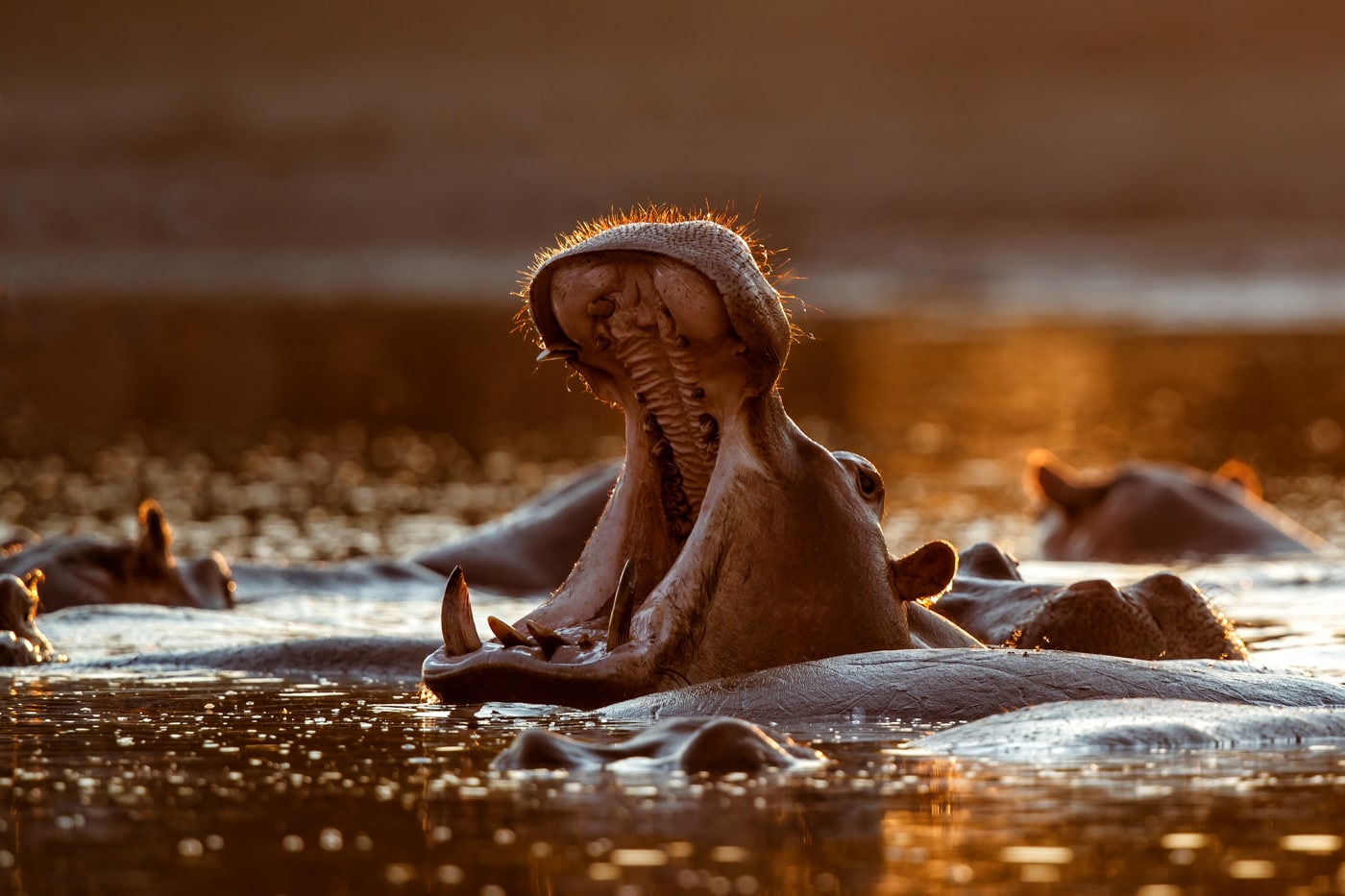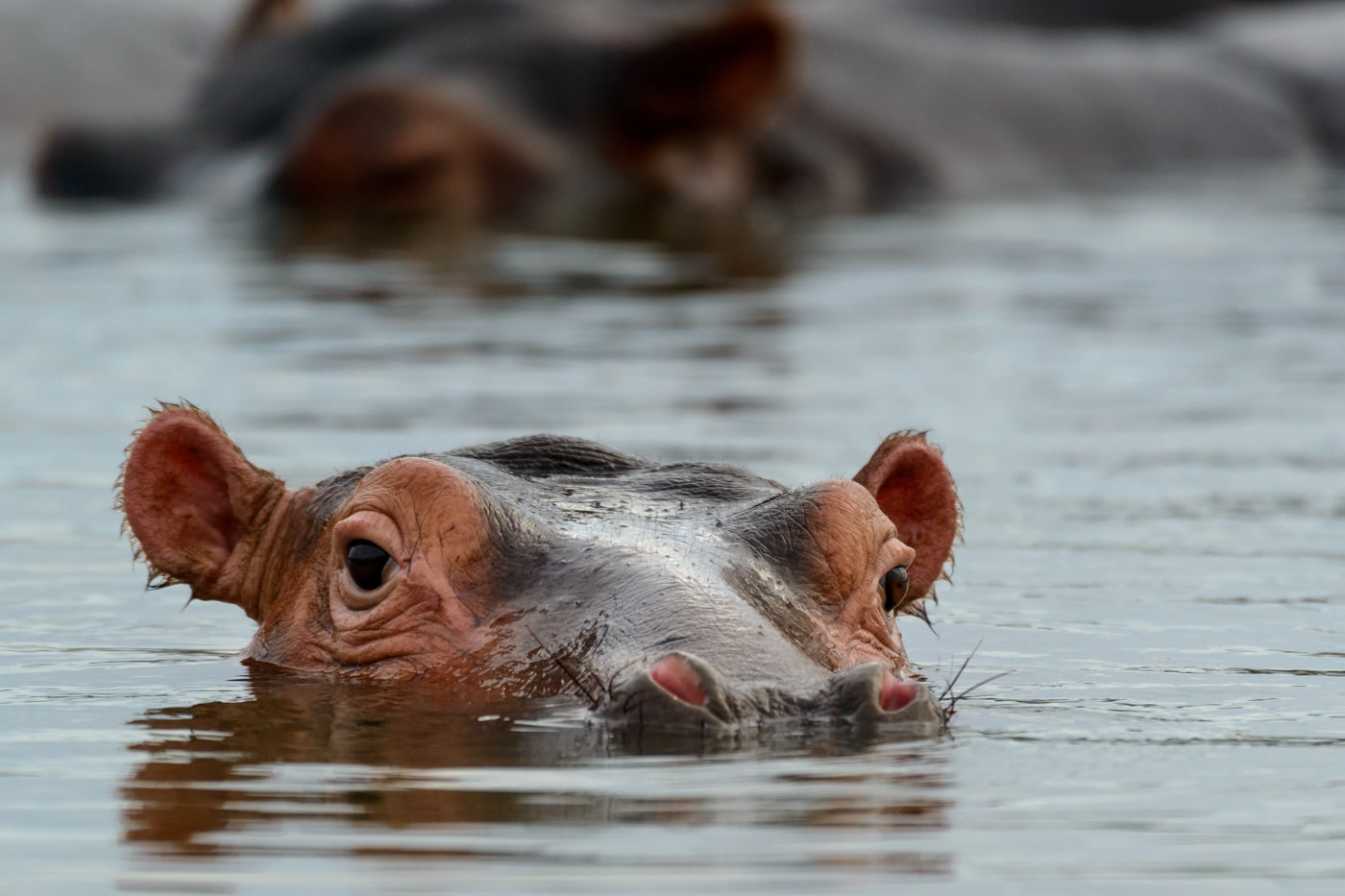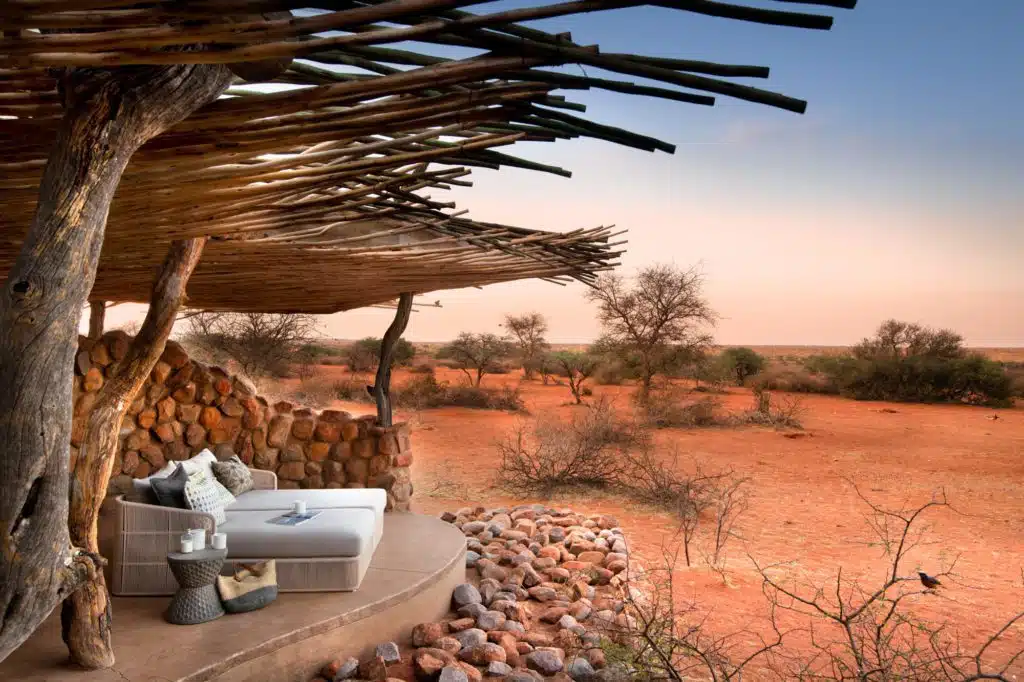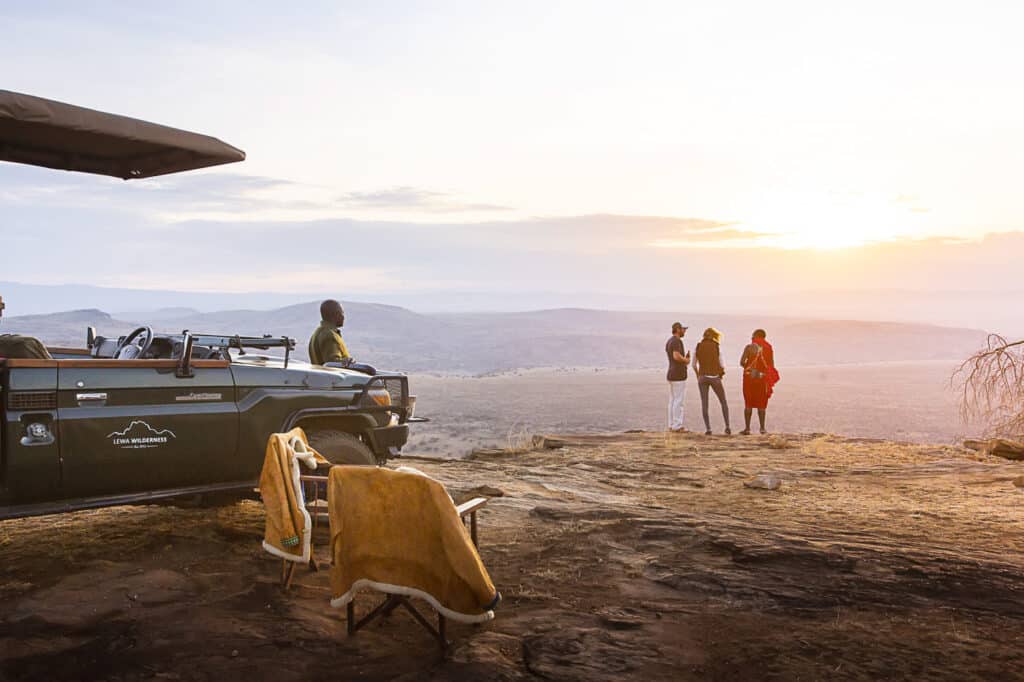FINDING HIPPOPOTAMUS
Africa’s Fearsome Vegans
Finding hippo is an often-repeated request of our clients.
One of the most misunderstood of Africa’s diverse fauna, these herbivorous behemoths are a sight to behold, their elegant if lethargic appearance filling one with wonder. But looks can be deceptive, and these sedate beasts are not to be trifled with.
Expert guides give hippopotamus a wide berth as they peer inquisitively from the depths, ears twitching and nostrils emitting a plume of water as they surface, almost akin to a breaching whale.
Hippos have a fascinating and ancient history. First emerging 16 million years ago, they used to be prevalent across the world, and evidence of their presence has been found in London’s Thames River and the Rhine in Germany. Like many species, their name is Latin in origin, directly translating as ‘water horse’, but in truth, they are more closely related to marine mammals than of equine origin.
Classified a vulnerable species, 130,000 hippo now live almost exclusively in Africa, the exception being a collection of 130 individuals in Colombia – the result of an escape. Sadly, poaching for bushmeat and ivory continues to diminish their numbers and hippo conservation through protection and re-education is a rapidly growing cause.
Despite spending much of their time wallowing in lakes and rivers, they are remarkably agile and can swim, lunge and walk on the riverbed surprisingly fast, usually to warn off threats. Though calves are sometimes hunted by lion and Nile crocodiles, foolish is the predator that challenges a full-grown hippo. Vegan in nature, hippo will emerge at night to eat grass, but spend much of their daytime snoozing or grazing beneath the surface, exhaling to reduce buoyancy, allowing them to walk underwater.
On land, they can easily outrun a human, reaching over 18 miles per hour (30km/h) in short bursts. This makes them particularly dangerous to people, and their fierce territorialism and protectiveness of their young results in several thousand human deaths per year, the most of any African mammal by many times. However, as a safari traveler, there is little to fear. Many waterside camps and lodges have secure viewing platforms, and in these areas hippo are more familiar with the passage of visitors. Guides are always particularly attentive to nearby schools or ‘bloats’ of hippo, and the easily distinguished body language of the large amphibious mammals clearly forewarns of any approach.
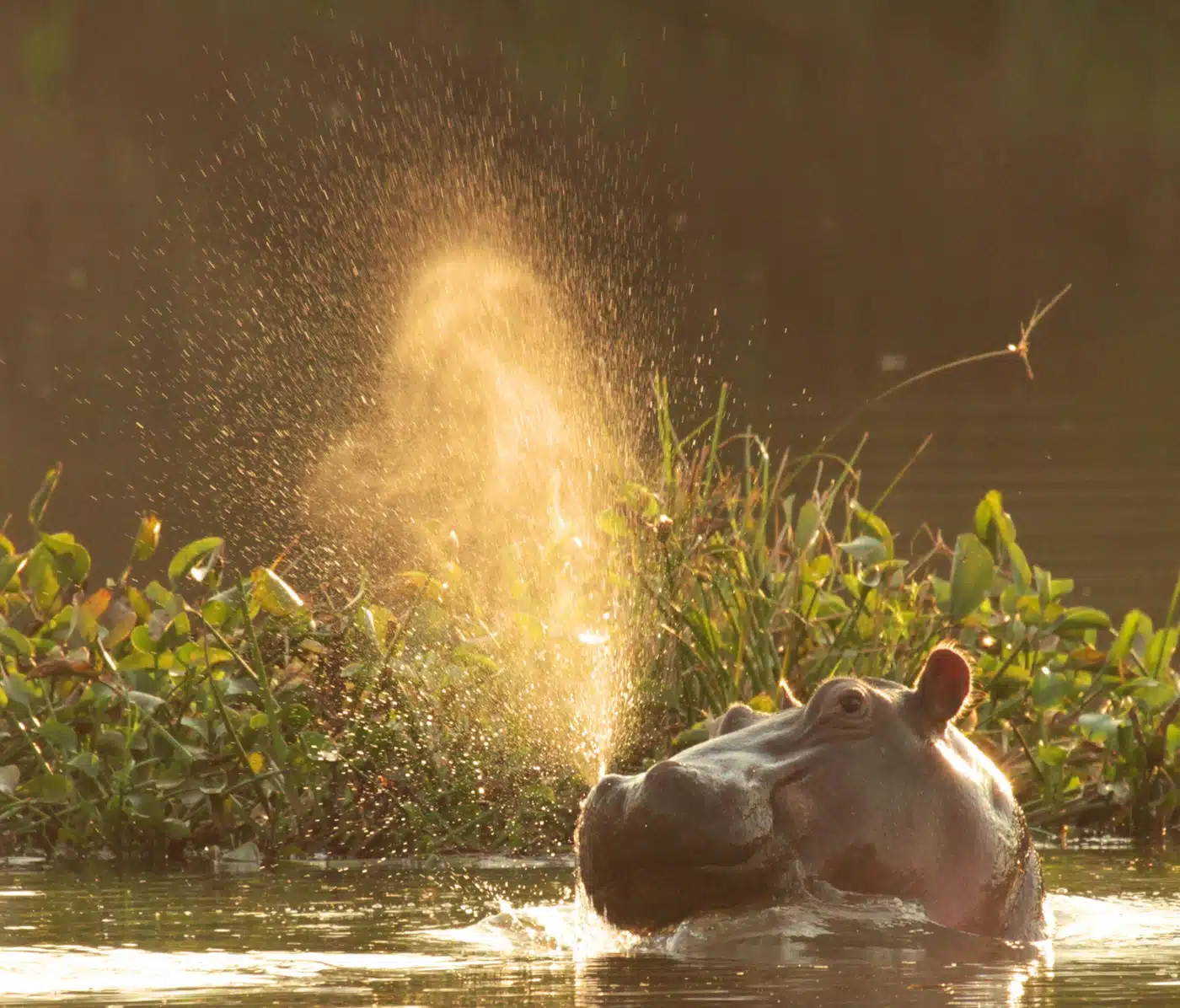
Much like whale spotters awaiting sporadic surfacing, viewing hippo is as much a matter of seeing peaking eyes and ears above the mirky water as it is watching hippo actively grazing or interacting. But similarly, their more elusive nature makes them truly fascinating and, despite their girth and stature, particularly endearing.
These are some of the best places for finding hippo in Africa:
- South Luangwa, Zambia
- Okavango Delta, Botswana
- Selous, Tanzania
- Kazinga Channel, Uganda
- Kruger National Park, South Africa
- Liwonde National Park, Malawi
South Luangwa, Zambia
Zambia‘s Zambezi and its tributaries are abundant in life, the all-but-permanent water source attracting local, regional and migratory species year-round. Lion, elephant, a variety of antelope and buffalo are regularly found, and wild dogs also have a healthy (if elusive) population here.
Hippos have taken up permanent residence in the region, the long grasses providing boundless sustenance for their insatiable appetite. As waters recede in the drier months, hippo congregate in number in the deeper pools and this can be dramatic – as bulls face off for territory and tempers fray – and tumultuous with dozens of individuals grunting and bellowing.

Adding to the abundance of hippo, diversity of wildlife and enduring waters, South Luangwa can be explored on foot, and the steep banks to be found in some areas offer the perfect, safe vantage point from which to view the hippo herds.
Recommended Camp:
Chinzombo Camp: Resting on the banks of a meandering curve of the Luangwa River, Chinzombo brings luxury to this exquisitely remote location. Resting on the elevated riverbanks each private villa presents stunning views across the waterway, with ample viewing of the resident hippo population, as well as visiting elephants and a spectrum of birdlife.
Okavango Delta, Botswana
As could be expected of one of the world’s most renowned water systems, the Okavango Delta is an exceptional home for hippos. Indeed, their impressive bulk and movements are partially responsible for the formation of the delta’s web of tributaries.

Though the waters run deep and its residents are often submerged, the drier periods encourage hippo to gather, and at dawn and dusk they can be observed grazing on the banks. What makes Botswana‘s Okavango exceptional is the ability to take waterborne safaris, by boat or mokoro. Hippo are always kept at a distance due to their unpredictability, but this water-level perspective provides an incredible opportunity to see these large mammals eye to eye.
Recommended Camp:
Xigera: With its stilted villas and living areas and a network of walkways and observation platforms, Xigera is wonderfully designed for viewing the delta up close yet from a safe elevation. One of Botswana’s few premier properties, Xigera offers unbridled luxury and superb vantage points, and the addition of a helicopter flight allows one to take a bird’s-eye perspective of the basking pods of hippo.
Selous, Tanzania
The expansive Rufiji River winds gracefully through Selous Game Reserve which, in turn, is located within the greater Nyerere National Park. The newly-established park is only five years old, but is one of the largest in the world, boasting high wildlife populations, including the Big Five.
Largely untouched, and its impressive size distributing visitors widely, Nyerere remains wonderfully exclusive and this is only exacerbated within the reserve of Selous. As with the world at large, water is life, and the rivers that feed the region bring a host of wildlife.
As with the hippo populations, safari camps take advantage of this, establishing themselves on the riverbanks for premier game viewing from elevated private balconies and the lodges’ public areas. As with the Okavango, boating is an excellent way to gain new perspectives on both wildlife and vistas, and it is a readily-available activity at most riverside properties.
Recommended Camp:
Sands River Selous: With every open-fronted room presenting expansive views of the waterway, Sands River Selous allows barely a moment of activity to pass unnoticed. Attentive staff alert guests to wildlife activity. The gentle rumble of hippos lulls guests to sleep at night, waking them at dawn as they retreat to the river to seek its cooling waters through the day’s sunshine.
Kazinga Channel, Uganda
Connected Lake George and Lake Edward, the Kazinga Channel forms the lifeblood of Uganda’s Queen Elizabeth National Park.
Though perhaps not on par with other destinations mentioned here, the Kazinga Channel has one unique advantage. While it is somewhat of a generalization, visitors to Uganda are there for one primary reason: its population fo mountain gorilla. While a valid quarry and the star attraction, the Kazinga Channel provides an additional attraction to Uganda.

Queen Elizabeth National Park contains Maramagambo forest at its heart, a wonderful location for primate trekking, including troupes of chimpanzees. The park is also home to rare tree-climbing lion, so there is a surprising amount of diversity and appeal to the small and less-frequented park.
Added to this, and despite being just 32 miles (51km) long, the Kazinga Channel possesses the highest population of hippo anywhere in the world, its low banks allowing them easy access to the waterway and its surrounding vegetation alike. While most excursions are public and on a set scehdule, private boat trips are also available at some properties.
Recommended Camp:
Ishasha Wilderness Camp: The gorilla trekking regions notwithstanding, Uganda isn’t known for its luxury accommodtions, and Queen Elizabeth National Park is no exception. However, Ishasha is amongst the few that have elevated to accommodate more discerning travelers. Certainly not of the standard found elsewhere, it is nonetheless perfectly adequate and places one in the best position to have access to the assorted attractions that the park offers. Overlooking the Ntungwe River, its riverside views are thoroughly appealing, though noticeably absent of hippo. For them, the Kazinga Channel is only a short drive away, more than compensating for their lacking at the camp.
Kruger National Park, South Africa
Though known more for its ground-dwelling wildlife, Kruger National Park in South Africa also plays host to significant hippo populations. Unlike the abundance of hippo in other regions, they don’t occur as regularly and must be sought out.
However, they a prevalent in numerous dams and waterholes and can be found wallowing sedately in number. The beauty of Kruger’s hippo viewing is that it can so easily be incorporated into a more expansive game drive. One can view lion, leopard, giraffe and elephant on the dry open regions before journeying to a river to see the resident hippo.
Kruger is a wonderful destination for incidental hippo watching, whereby the grazing water mammals form just one portion of the classical safari experience.
Recommended Camp:
Singita Lebombo: Luxury abounds at Singita Lebombo and its dramatic gorge-top perch is awe-inspiring. This exquisite property is among the best in South Africa and game drives take in the nature surrounding the N’wanetsi River over which the lodge stands. If hippo are on your must-see list, this can be accommodated, though it shouldn’t be expected that hippo will serenade you as you dine at the lodge’s gourmet restaurant or wake you with their dawn chorus.
Liwonde National Park, Malawi
Although Malawi isn’t one of our favored safari destinations, it is wonderfully charming and distinctly different from most other African nations.
The wetlands of Liwonde have superb elephant, crocodile and hippo viewing, and walking safaris increase the spectacular nature of the park. Here too, one can find the critically endangered black rhino, itself a highly sought-after game experience. Birding in Liwonde is also a key attraction, particularly for the rare Pel’s fishing owl, as well as bee-eaters, love birds, and flycatchers.
Bordering Lake Malombe, the park is superbly diverse, with hillscapes, wetlands and lakeshore vistas, and this adds variety to game-viewing activities. Due to this, one can take numerous game drives, each being distinctly different.
Beyond Liwonde, Lake Malawi to the north is a unique experience of its own, offering sailing, fishing, diving and beachside tranquility, despite being entirely landlocked.
Recommended Camp:
Tongole Wilderness Retreat: Though not luxury, Tongole is charmingly rustic, evoking the impression of a sprawling treehouse. The wonderfully hospitable staff are incredibly attentive and will assist in making the very most of a visit, in service and in activities. Tongole is not a property for those preferring exceptional accommodation and first-class creature comforts, but in its unique and endearing nature it will leave a lasting impression.
Hippos aren’t everyone’s most desired of game animals; the big cats, endangered rhino, gorilla and other celebrities of African wildlife often take precedent. But with their delightful smiles, sonorous rumblings and impressive size, they still make for wonderful viewing. Calving takes place between October and April, optimizing the high-water times of year, and the lovable little ones heighten the experience for viewers.
From aardvarks to zebra, if there is a specific species you wish to see, our Travel Designers will suggest the very best locations and times of year to visit Africa.




